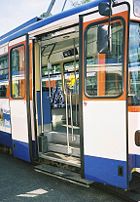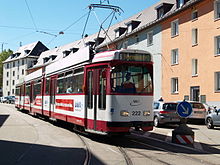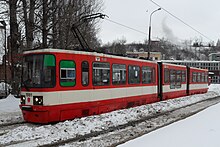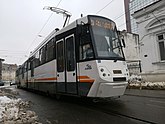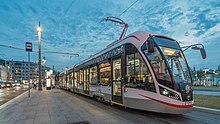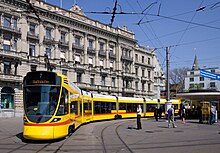
The Alstom Citadis is a family of low-floor trams and light rail vehicles built by Alstom. As of 2017, over 2,300 Citadis trams have been sold and 1,800 tramways are in revenue service throughout the world, with operations in all six inhabited continents. An evolution of Alstom's earlier TFS vehicle, most Citadis vehicles are made in Alstom's factories in La Rochelle, Reichshoffen and Valenciennes, France, and in Barcelona, Spain, and Annaba, Algeria.

The Bombardier Flexity Swift is a series of urban and inter-urban tram, light rail and light metro vehicles manufactured by Bombardier Transportation. It is part of the Bombardier Flexity family of rail vehicles, and like the others, Flexity Swift vehicles can be customized to suit the needs and requirements of customers including legacy designs from its acquisition of Adtranz.
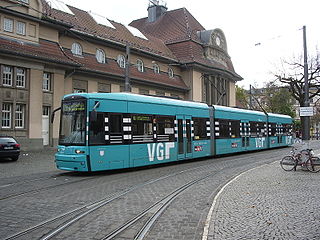
The Bombardier Flexity Classic is a model of light-rail tram manufactured by Bombardier Transportation. Although it is marketed as the most traditionally designed member of the Flexity family, it is still a modern bi-directional articulated tram with a low-floor section allowing good accessibility, especially to passengers in wheelchairs. Flexity Classic trams run on 1,435 mmstandard gauge in Australia, 1,000 mmmetre gauge in Essen, 1,450 mm in Dresden, and 1,458 mm in Leipzig.

Silesian Trams is one of the largest tram systems in the world and the largest and longest tram system in Poland, located entirely within the Silesian Voivodeship. Started as a part of the German Empire in 1894, the system currently has 677 stops across 29 lines and serves the region’s population inhabited by more than two million people. Silesian Trams is at the heart of a region known for its dense historical and current industrialisation.
The West Midlands Metro is a passenger light rail line in the West Midlands conurbation in England, which opened in 1999. Its rolling stock consists of 21 CAF Urbos 3 trams which came into service in 2014/15, replacing the older T-69 trams which had operated the line since 1999.

The ADtranz low floor tram was introduced in the 1990s as the world's first tram with a completely low floor design. This tram was developed by MAN for the Bremen urban transport system. The prototype, tram number 3801, was first publicly introduced on 9 February 1990. From 1991 to 1993, it was being tested in many European cities. Ten German cities have purchased this type. Adtranz took over the rail division of MAN in 1990.

Germany has an extensive number of tramway networks. Some of these networks have been upgraded to light rail standards, called Stadtbahn in German. Straßenbahn and Stadtbahn schemes are usually operated on the legal foundation of the BOStrab, the Tramways Act of Germany.

The Nantes tramway is a tramway system operating in the city of Nantes in Pays de la Loire, France. The first tramway in Nantes opened in 1879 and closed in 1958 due to bombing damage during World War II, while the present tramway was re-introduced to the city in 1985.

The Tramway Français Standard (TFS) is a type of tram designed and manufactured by Alstom for use on various tramway systems in France. The TFS is no longer in production, having been superseded by the Alstom Citadis range of tramcars.
The Little Dancer is a low-floor tram brand built by Alna Sharyo, a Japanese manufacturer of trams and light rail vehicles.

The Karlsruhe Stadtbahn is a German tram-train system combining tram lines in the city of Karlsruhe with railway lines in the surrounding countryside, serving the entire region of the middle upper Rhine valley and creating connections to neighbouring regions. The Stadtbahn combines an efficient urban railway in the city with an S-Bahn, overcoming the boundary between trams and trains. Its logo does not include the green and white S-Bahn symbol used in other German suburban rail systems and the symbol is only used at stops and stations outside the inner-city tram-operation area.
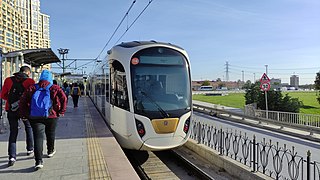
The Istanbul Tram is a modern tram system on the European side of Istanbul. The first section, the T1 opened in 1992, followed by the T2, which opened in 2006. In 2011, the T1 and T2 merged, with the line retaining the T1 name. The T4, T5 and the T6 lines followed, opening in 2007, 2021 and 2024 respectively.

In 2012, Blackpool Council ordered 16 Bombardier Flexity 2 trams for the Blackpool Tramway, becoming the worldwide launch customer for Bombardier Transportation's new design. The modern 100% low-floor trams replaced the Blackpool Tramway's tourist-focused and high maintenance heritage fleet, some of which have been retained with modifications for use as a supplementary fleet alongside the Flexity 2 trams and some for tourist services on the promenade. Blackpool's Flexity 2 trams are intended to be suitable for daily commuters and to provide a service competitive with other modes of transport and comply with legislation on accessibility for disabled users.

The Bombardier CR4000 is a 76% low floor model of the Bombardier Flexity Swift series of tram operated by Tramlink in London. They are based on and very similar in appearance to the K4000 used on the low-platform routes of the Cologne Stadtbahn network. Built between 1998 and 2000, the trams entered service in the spring of 2000.

The Kraków tram system is a tram system in Kraków, Poland. The tramway has been in operation since 1882, and is currently operated by Miejskie Przedsiębiorstwo Komunikacyjne w Krakowie. There are 22 ordinary, 2 fast, and 3 night tram lines with a total line length of 347 kilometres (216 mi). As of 2013, the total route length of the tramway was 90 kilometres (56 mi), including a 1.4-kilometre (0.87 mi) tram tunnel with two underground stops.

High-floor describes the interior flooring of commuter vehicles primarily used in public transport such as trains, light rail cars and other rail vehicles, along with buses and trolleybuses. Interior floor height is generally measured above the street surface or above the top of the rail. High-floor designs usually result from packaging requirements: mechanical items such as axles, motors, crankshafts, and/or transmissions, or luggage storage spaces are traditionally placed under the interior floor of these vehicles. The term is used in contrast with low-floor designs, which offer a decreased floor and entry height above the street surface. Since low-floor designs generally were developed after high-floor vehicles, the older high-floor design is sometimes also known as conventional or the “traditional” design.

The Alstom Flexity is a family of trams, streetcars, and light rail vehicles manufactured by Bombardier Transportation, since 2021 a division of French company Alstom. As of 2015, more than 3,500 Flexity vehicles are in operation around the world in Europe, Asia, Oceania, and North America in 100 cities among 20 countries internationally. Production of the vehicles is done at Bombardier's global production plants and by local manufacturers worldwide through technology transfer agreements.

The T1, officially referred to as the T1 Kabataş–Bağcılar tram line is a tram line of the Istanbul Tram, operated by Metro Istanbul. It runs from Kabataş to Bağcılar via Eminönü, with a total length of 19.3 km (12.0 mi).
Trams have been used since the 19th century, and since then, there have been various uses and designs for trams around the world. This article covers the many design types, most notably the articulated, double-decker, drop-centre, low-floor, single ended, double-ended, rubber -tired, and tram-train; and the various uses of trams, both historical and current, most notably cargo trams, a dog car, hearse tram, maintenance trams, a mobile library service, a nursery tram, a restaurant tram, a tourist tram, and as mobile offices.
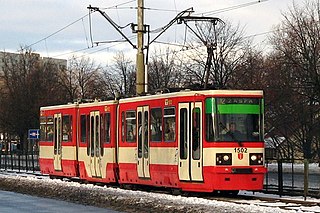
Konstal 114Na is an articulated low-floor tram, manufactured in 1997 by Konstal works in Chorzów, in a quantity of 2 units for the Gdańsk Municipal Transport Company. It is the second low-floor tram type produced in Poland after the 112N. A significant part of the solutions was taken from the previously produced single unit of the 112N type.


